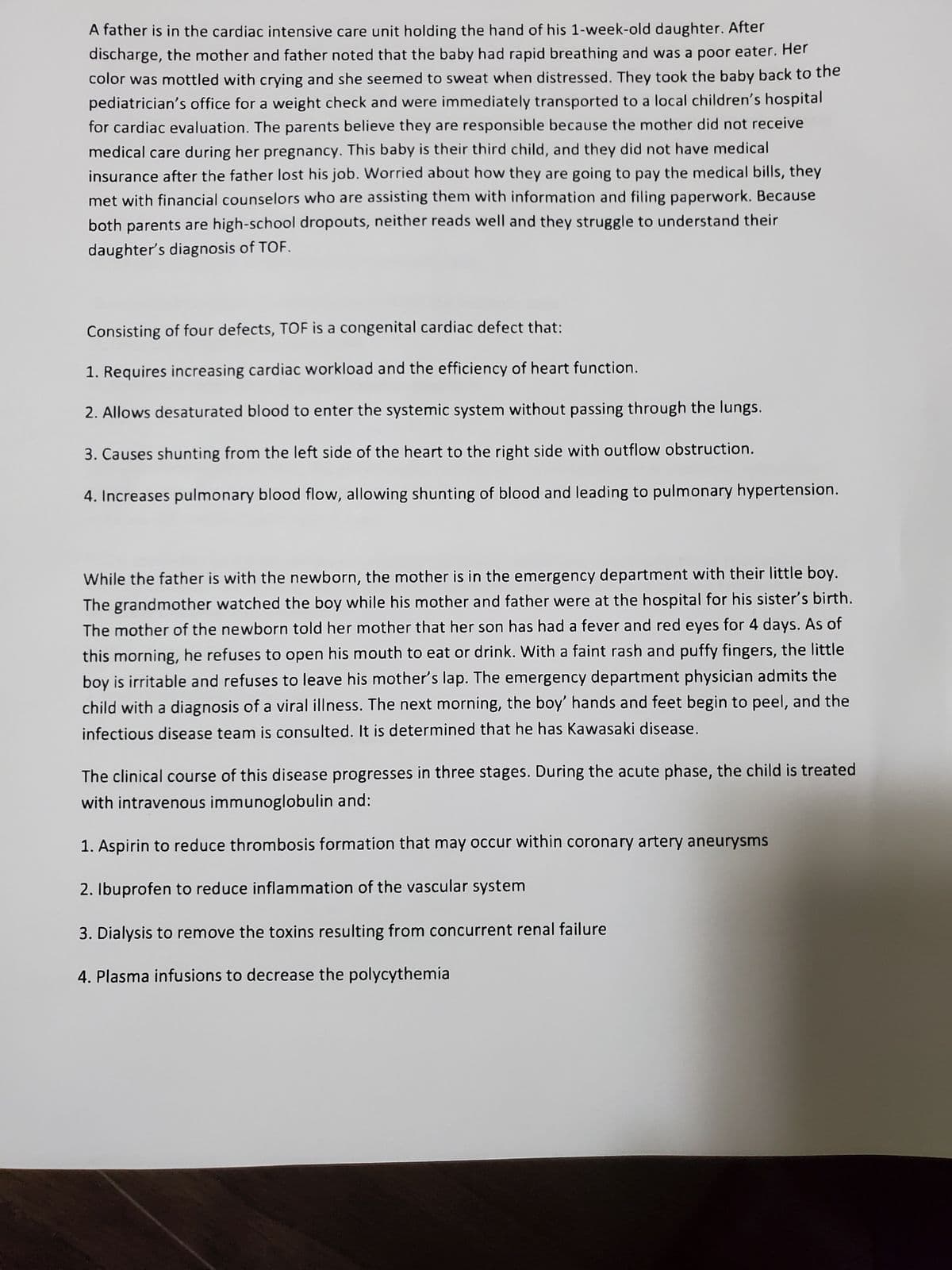Chapter19: Child Health
Section: Chapter Questions
Problem K1CRE
Related questions
Question
Answer 1.

Transcribed Image Text:A father is in the cardiac intensive care unit holding the hand of his 1-week-old daughter. After
discharge, the mother and father noted that the baby had rapid breathing and was a poor eater. Her
color was mottled with crying and she seemed to sweat when distressed. They took the baby back to the
pediatrician's office for a weight check and were immediately transported to a local children's hospital
for cardiac evaluation. The parents believe they are responsible because the mother did not receive
medical care during her pregnancy. This baby is their third child, and they did not have medical
insurance after the father lost his job. Worried about how they are going to pay the medical bills, they
met with financial counselors who are assisting them with information and filing paperwork. Because
both parents are high-school dropouts, neither reads well and they struggle to understand their
daughter's diagnosis of TOF.
Consisting of four defects, TOF is a congenital cardiac defect that:
1. Requires increasing cardiac workload and the efficiency of heart function.
2. Allows desaturated blood to enter the systemic system without passing through the lungs.
3. Causes shunting from the left side of the heart to the right side with outflow obstruction.
4. Increases pulmonary blood flow, allowing shunting of blood and leading to pulmonary hypertension.
While the father is with the newborn, the mother is in the emergency department with their little boy.
The grandmother watched the boy while his mother and father were at the hospital for his sister's birth.
The mother of the newborn told her mother that her son has had a fever and red eyes for 4 days. As of
this morning, he refuses to open his mouth to eat or drink. With a faint rash and puffy fingers, the little
boy is irritable and refuses to leave his mother's lap. The emergency department physician admits the
child with a diagnosis of a viral illness. The next morning, the boy' hands and feet begin to peel, and the
infectious disease team is consulted. It is determined that he has Kawasaki disease.
The clinical course of this disease progresses in three stages. During the acute phase, the child is treated
with intravenous immunoglobulin and:
1. Aspirin to reduce thrombosis formation that may occur within coronary artery aneurysms
2. Ibuprofen to reduce inflammation of the vascular system
3. Dialysis to remove the toxins resulting from concurrent renal failure
4. Plasma infusions to decrease the polycythemia
Expert Solution
This question has been solved!
Explore an expertly crafted, step-by-step solution for a thorough understanding of key concepts.
Step by step
Solved in 2 steps

Recommended textbooks for you



Surgical Tech For Surgical Tech Pos Care
Health & Nutrition
ISBN:
9781337648868
Author:
Association
Publisher:
Cengage



Surgical Tech For Surgical Tech Pos Care
Health & Nutrition
ISBN:
9781337648868
Author:
Association
Publisher:
Cengage

Comprehensive Medical Assisting: Administrative a…
Nursing
ISBN:
9781305964792
Author:
Wilburta Q. Lindh, Carol D. Tamparo, Barbara M. Dahl, Julie Morris, Cindy Correa
Publisher:
Cengage Learning

